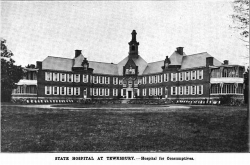Tewksbury State Hospital
| Tewksbury State Hospital | |
|---|---|
 | |
| Construction Began | 1852 |
| Opened | 1854 |
| Current Status | Active |
| Building Style | Cottage Plan |
| Alternate Names |
|
Contents
History[edit]
The hospital was established in 1852 as one of three state almshouses needed to help care for the unprecedented influx of immigrants into Massachusetts at that time. The almshouses were the Commonwealth's first venture into caring for the poor, a duty which had previously been carried out by the cities and towns. Opened on May 1, 1854 with a capacity for 500, the almshouse population grew to 668 by the end of the first week, and to over 800 by May 20th. By December 2, 1854, 2,193 "paupers" had been admitted. Nearly 90% of these listed European countries as their birthplace. The almshouse reported having 14 employees at that time, and was spending 94.5 cents per week per resident.
In 1866 the almshouse began accepting the "pauper insane" becoming the state's first facility to specifically accept cases with the diagnosis of chronic insanity. By 1874 the facility had become diversified: 40% was used as a mental illness ward, 27% as a hospital ward, and 33% as an almshouse. The chronically ill population continued to grow, alcoholics were admitted for treatment, and programs providing therapeutic industrial and occupational therapy were added in the 1870's. A Home Training School for Nurses was established in 1894, and the school became a full-fledged three-year program in 1898.
The most famous patient in the almshouse during the 19th century was Anne Sullivan, who later became the tutor and companion of Helen Keller. Anne Sullivan spent four years at the almshouse (1876-1880) before being transferred to the Perkins School for the Blind, now located in Watertown, Massachusetts. At age 20 she left the school to go to Helen Keller's home in Alabama. One of the buildings on today's Tewksbury Hospital Campus is named for Ms. Sullivan.
Reflecting its changing mission, the Tewksbury Almshouse became Tewksbury State Hospital in 1900, the Massachusetts State Infirmary in 1909, and Tewksbury State Hospital and Infirmary in 1938. Over the years, facilities were added for treating tuberculosis and other contagious diseases such as smallpox, venereal diseases and typhoid fever. Meanwhile it continued to serve as a last resort for many patients in need of shelter and supervised care, especially during the late 1920's and 1930's.[1]
Images of Tewksbury State Hospital[edit]
Main Image Gallery: Tewksbury State Hospital
Videos[edit]
- In the following twenty minute video the Hip Bee Explorer visited the Historic Tewksbury Hospital and its public Health Museum.
Cemetery[edit]
There are three cemeteries on the grounds of Tewksbury Hospital with at least 10,000 graves in them. The cemetery directory dates back to 1891 and contains 9,342 names. Patients who died between 1854 and 1891 are not recorded, so the total number of graves is not known. The grave markers, three-inch high metal circles with crosses in the middle, are rusted and easy to miss because of the overgrowth of weeds. Although on occasion community groups have done some clearing of overgrowth in the cemeteries, the hospital has no money in its budget for regular maintenance.
References[edit]
Museum Information[edit]
Public Health Museuum
365 East Street, Tewksbury, MA 01876
978-851-7321, Ext 2606
Museum website

